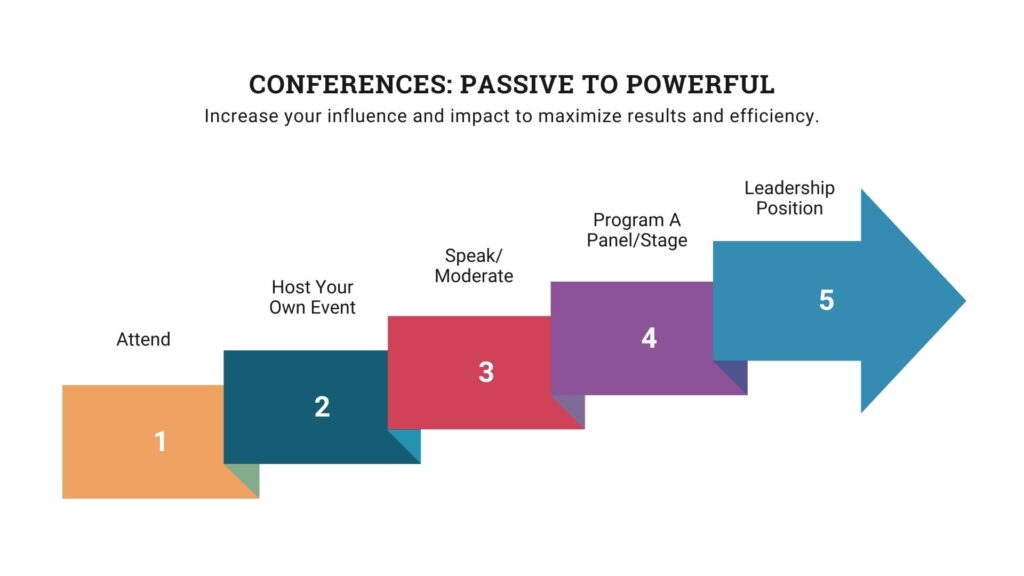How to Maximize Your Attendance At Conferences
Posted on April 19th, 2024 to Uncategorized
During my corporate sales career, I relished the opportunity to attend conferences.
They offered a refreshing break from my daily routine, filled with travel, learning, inspiration, and the chance to forge new connections.
Despite my enthusiasm, these events often came with a heavy dose of stress. My sales managers demanded tangible results—insisting on a solid return on their investment in both the conference fees and my time away from the office.
I always wished they understood that the true value of these conferences unfolds over time, and it pays to play the long game, rather than expecting immediate gains.
Now, as the founder of my own consultancy, I commit to attending the same three conferences annually, for at least two years in a row.
This approach allows me to understand the conference dynamics—the lay of the land—enabling me to attend more powerfully and with more influence the following year.
You may be wondering what I mean by attending with influence?
In this blog post, I’ll explain what it means to show up powerfully vs. passively by sharing the three key strategies I employed before, during, and after a conference I recently attended.
Let’s dive in.
Defining Passive to Powerful at Conferences
So, what do I mean by going from passive to powerful when you attend conferences?
Showing up powerfully or with influence involves having a role in the conference — perhaps as a keynote speaker, workshop facilitator, panelist, advisory board or steering committee member — which can significantly elevate your credibility and visibility within the conference.
However, as a first-timer, the chances of stepping in as a featured speaker or panelist are slim.
And as an attendee, the reality is that navigating crowds to make meaningful connections — whether it’s 50 or 5,000 people — can often feel more like hustling than genuine relationship-building.

So how do you make the most of your attendance at a conference where you wield no real influence?
In the following sections, I’ll share how I prepared to ensure I got the most out of a conference I recently attended for the first-time and which strategies proved successful.
First up, research and preparation.
1. Preparation for Conferences
It’s never a good idea to show up at a conference without some level of preparation, even if you’ve been attending for many years.
But it’s absolutely critical to be strategic about conferences that you’ve never attended before.
As I mentioned in the section above, I recently decided to attend a new conference for the first-time, and I knew I’d have to get really intentional about preparing for it in order to get the most out of it.
The first thing I did was identify all the key stakeholders at the conference, including:
- Existing Customers
- New Leads
- Strategic Referral Partners (other service providers already working with your ideal customers so you can share referrals)
- Speakers
- Conference Leaders (people who have decision-making power or influence over you getting on stage or other positions of authority)
Then, once I made a list of everyone I wanted to connect with, I brainstormed opportunities with each one based on their role, interests and what I knew about their work.
Then I practiced my elevator pitch, as well as questions I would ask each type of stakeholder, to make any opportunities to meet them as compelling as possible.
By doing this prep work upfront, I was in a position to meet important connections with confidence, even without a formal role at the conference.
2. Optimize Introductions
I don’t know about you, but I find prospecting to be so disempowering.
To try to find an attendee or a speaker in a sea of 5,000 people, who may be your ideal client, and introduce yourself in a way that doesn’t feel salesy or slimy, all in a 32-second window is daunting.
For most subject-matter experts that I work with, this approach doesn’t feel authentic or effective either.
Instead, I suggest optimizing your introductions by focusing on the one person who can get you in front of dozens of people over time more powerfully.
Focus On Key Conference Leaders
At this conference, I looked for any opportunity to find someone who could grant me better access to new communities and groups of my ideal customers within the conference.
Specifically, I attended a session hosted by conference leaders about their educational programs for small business owners, which of course includes sales.
But instead of shaking hands with every small business owner in that room, and hoping that I can influence them in 30 seconds to have a call with me – exhausting! – I introduced myself to the three women who head up educational programming.
During the conversation, I asked if they needed more sales instructors because I’d love to volunteer my time.
One of them was thrilled and asked to connect outside the conference to continue the conversation.
Let me sum this up: Instead of trying to meet dozens of leads in a disempowered way, I focused on the few folks in the room who get me in front of my ideal clients in a more empowered and influential way later.
| Case Study: A Client Success Story One of my clients worked in change management and was granted a speaking role at the conference for corporate leaders who work in organizational development. As we strategized how to maximize his attendance, we settled on a single goal: deepening relationships with conference leaders. He went through the steps in this blog post, and stayed true to his goal of making meaningful connections with key stakeholders. After the conference, he stayed in touch and by asking what they needed to be successful, he discovered that they wanted more C-Suite speakers. He seized the opportunity to coordinate a panel of his clients and reach out to other influential people with whom he wanted to gain visibility. By taking this long-term approach, he deepened relationships with conference leaders and secured an advisory board spot — a position that will enable him to share opportunities with key customers and leads into the future! |
Have An Invite
While shaking hands with as many ideal clients as possible at a conference isn’t the most empowered approach, you will meet leads!
In this instance, you’ll want to have an invite that offers an easy win for them and feels like a natural next step.
For the conference, I was prepared to offer qualified leads two opportunities:
- To join my next free, monthly Sales Roundtable for founders and subject-matter experts.
- To book a “30/30” call with me, where I get 30 mins to ask them market research questions (highly valuable for me), and they get 30 mins of sales coaching.
For the right person, an offer of 30 minutes of my time dedicated to their specific sales questions and challenges was really attractive.
The important thing to note here is that your 30-minute consulting offer for 30 minutes of their time needs to be authentic.
Most people are weary of getting on calls because they assume a sales pitch is coming, so it’s vital to build trust by having some well-thought-out questions that you will apply to your business in earnest.
Here’s how my offer sounded:
| “Hey, I’m creating a new learning module for small business owners and lead generation, and I’d love your feedback as you are exactly who I’m creating it for. In exchange for 30 minutes of your time, I’ll answer your sales-related questions in the second half of the call.” |
Next, I’ll share the final strategy I used to make the first-time attending the conference successful.
3. Leverage Existing Relationships
Not many subject-matter experts I know look forward to walking into a large conference they’ve never attended before alone.
That’s why I advocate for my clients to leverage the existing relationships they have, whether it’s customers they know will be in attendance or partnering up with colleagues or peers.
And while conferences can feel really lonely and bewildering, there are more benefits to rolling with a conference crew than not being alone.
Here are three ways I benefited from attending the last conference with two of my colleagues:
Accountability – It’s easier to skip a talk or keynote due to work demands, but not when you have two colleagues waiting for you in the lobby!
Plus, attending with others presents the opportunity to practice your elevator pitch (over tacos and margaritas?) or reflect on what you’ve learned and mastermind with each other about how to apply it.
Easy Introductions — We know each other’s work, so we could speak to each other’s authority. That means, I didn’t have to introduce myself a whole lot throughout the week, because my crew were introducing me and vice versa.
Credibility-Boosters — As an emotionally-intelligent subject matter expert, it’s much easier for us to toot other people’s horns. Facilitating conversations and introductions for others leads to more free-flowing conversations and less pressure to strike up 1:1 talks. But we still get in on the action.
Rolling with a crew makes the conference experience much more enjoyable and productive, but if you can’t attend with others, I have another strategy to share.
Identify Affinity Groups
Do you belong to an association, professional network or support an organization?
Affinity groups are often based on things like gender identity, sexual orientation, race, geography, industry, service, working parents, solopreneurs, to name just a few.
If so, do some research into whether they’ll have a presence at the conference or if one of your fellow members is planning to attend.
At the conference I’ve been referencing, one of the best things I did was meet up with the NGLCC (National Gay and Lesbian Chamber of Commerce).
It was a small group of people with a shared mission — and because it was more intimate, we could have a conversation, making networking and building relationships less awkward and more personal .
And last but definitely not least, existing customers.
Existing Customers
I always advocate to meet customers in person whenever possible and conferences are an ideal setting.
In addition to taking the initiative to meet up and deepen your relationships, it’s a great way to share those informal moments and let your hair down outside of the realm of project work.
Since you know them, you can add value by introducing clients to each other, building your own community of peers and colleagues with you as a mutual connection.
Clients will appreciate you going out of your way to meet up with them and adding value to their conference experience.
Recap and Key Takeaways
So there you have it. I’ve shared my top three strategies for maximizing your impact at conferences you’re attending for the first time.
It pays to view attending conferences as a long-term strategy that requires:
Intentional Preparation: Before the conference, identify key stakeholders you want to meet, prepare how you’ll introduce yourself with your elevator pitch, and set clear goals for what you want to achieve.
Optimize Introductions: Focus on meeting with influential conference leaders and decision-makers, rather than trying to meet as many people as possible. Have compelling invites ready to engage meaningfully with potential clients or partners.
Leverage Relationships: Lean into your existing relationships with colleagues, clients and affinity groups to enhance your presence and influence at the conference. Attending with a ‘crew’ can help facilitate introductions, boost your credibility and make networking a little less awkward.
I hope these insights help you approach your next conference with confidence and a clear plan to make the most out of your conference experience.
Want more conference best practices? Read more here.
Have an upcoming conference and want to talk strategy? Attend the next free Sales Roundtable by registering here.





